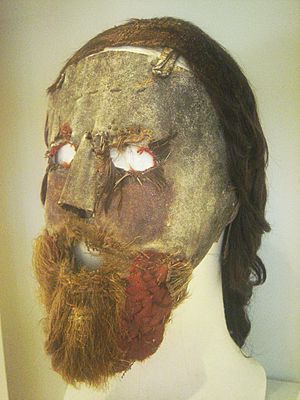Alexander Peden facts for kids
Quick facts for kids Alexander Peden |
|
|---|---|

Peden's cloth mask and wig displayed in the Museum of Scotland
|
|
| Religion | Christianity |
| School | Presbyterianism |
| Personal | |
| Born | 1626 Sorn, Ayrshire, Scotland |
| Died | January 26, 1686 (aged 59–60) Sorn, Ayrshire, Scotland |
| Resting place | Cumnock, Scotland 55°27′19″N 4°15′44″W / 55.455364°N 4.262325°W |
Alexander Peden (1626–1686) was a very important leader in a group called the Covenanters in Scotland. People also called him "Prophet Peden" because they believed he could see the future.
Contents
Alexander Peden's Early Life
Alexander Peden was born around 1626. His family lived on Auchincloich Farm near Sorn in Ayrshire, Scotland. His father was a small farmer.
We don't know much about Peden's early schooling. But he did study at the University of Glasgow from 1643 to 1648. After university, he worked as a schoolteacher in places like Tarbolton and Fenwick.
In 1660, Alexander Peden became a minister in New Luce in Wigtownshire. Before he became a minister, someone made a false accusation against him, but it was proven wrong. In 1662, a new law meant he could no longer be a minister in his church. When he preached his last sermon, he stayed in the pulpit until it was dark. As he left, he reportedly knocked on the pulpit door three times with his Bible. He said that only true ministers should enter it.
Peden as a Field Preacher
After losing his church, Peden became a famous "field preacher." This meant he preached outdoors, often in secret. He traveled all over southern Scotland. He had a special way of speaking that people found inspiring. Many believed he had prophetic gifts. His difficult life and narrow escapes from capture made people respect him even more.
After King Charles II returned to power in 1660, Peden had to leave his parish in 1663. For ten years, he traveled widely. He helped and comforted other Covenanters. He often just barely escaped being caught. He even spent some time hiding in Ireland. To avoid being recognized, Peden wore a cloth mask and a wig. You can see these items today in the Museum of Scotland in Edinburgh.
In 1666, Peden was declared a rebel. He was not pardoned after the Battle of Rullion Green. In 1667, he became a fugitive, meaning he was on the run. He went to Ireland in 1670 but came back to Scotland in 1673.
Imprisonment and Banishment
In June 1673, Peden was captured while holding a secret church meeting (called a conventicle). He was sent to prison for over four years on the Bass Rock. This was a lonely island in the sea. After that, he spent another 15 months in the Edinburgh Tolbooth prison.
He tried to get released, but his request was denied. Instead, he was sentenced to be banished forever. In December 1678, Peden and 60 other Covenanters were sent to London. From there, they were supposed to be sent to the American colonies. However, the American ship captain learned that they were being banished for their religious beliefs, not as criminals. He refused to take them. So, Peden and the others were set free. Peden then found his way back to Scotland and later to northern Ireland again.
A Famous Prophecy
In 1682, Peden performed the wedding ceremony for John Brown and his second wife, Isabel Weir. After the wedding, Peden told Isabel something surprising. He said she had a good husband, but she would not have him for long. He told her to keep linen ready for his burial cloth, because she would need it when she least expected it, and it would be bloody.
Three years later, on May 1, 1685, soldiers led by Captain John Graham of Claverhouse shot John Brown. Brown was killed because he refused to take an oath against his Covenanter beliefs. Peden was about 11 miles away. He prayed for John Brown, asking God to remember his death. Peden later told others that he had a vision of Brown's wife crying over his body and of Claverhouse killing him.
Alexander Peden's Death
Peden's difficult life and constant worries made him very sick. He decided to spend his last days in his home area. He found shelter in a cave near his brother's farm.
Feeling that he didn't have much time left, he went to his brother's farm one evening. He died there on January 28, 1686. He was first buried in a church in Auchinleck.
About 40 days later, soldiers dug up his body. They took it to the gallows in Cumnock and planned to hang it in chains. But a local nobleman objected. So, they buried Peden's body at the foot of the gallows instead. In 1891, a monument was built to mark this spot. After the Glorious Revolution in 1688, the people of Cumnock started burying their dead around the gallows hill, showing their great respect for Peden.
Peden was one of the most respected Covenanter preachers. His influence on people was so strong that they called him "The Prophet." They believed he truly had a gift for seeing the future.
Alexander Peden Stone
The Alexander Peden Stone is located south of Harthill in Shotts. This was one of the places where Alexander Peden and other Covenanters secretly preached. A monument was put up around 1866. It is looked after by a local Covenanters' group. The large stone that the monument sits on was likely used as a platform for preachers.
See Also
- Peden's Cave, Craigie
Images for kids
-
The Bass Rock, East Lothian. Peden was imprisoned here for over five years.
-
Peden at Richard Cameron's grave. Peden reportedly said "Oh to be wi thee, Ritchie!"
-
The Marriage of the Covenanter, by Alexander Johnston. Alexander Peden led the wedding of John Brown in 1682.
-
Alexander Peden's gravestone, Cumnock, East Ayrshire, Scotland









